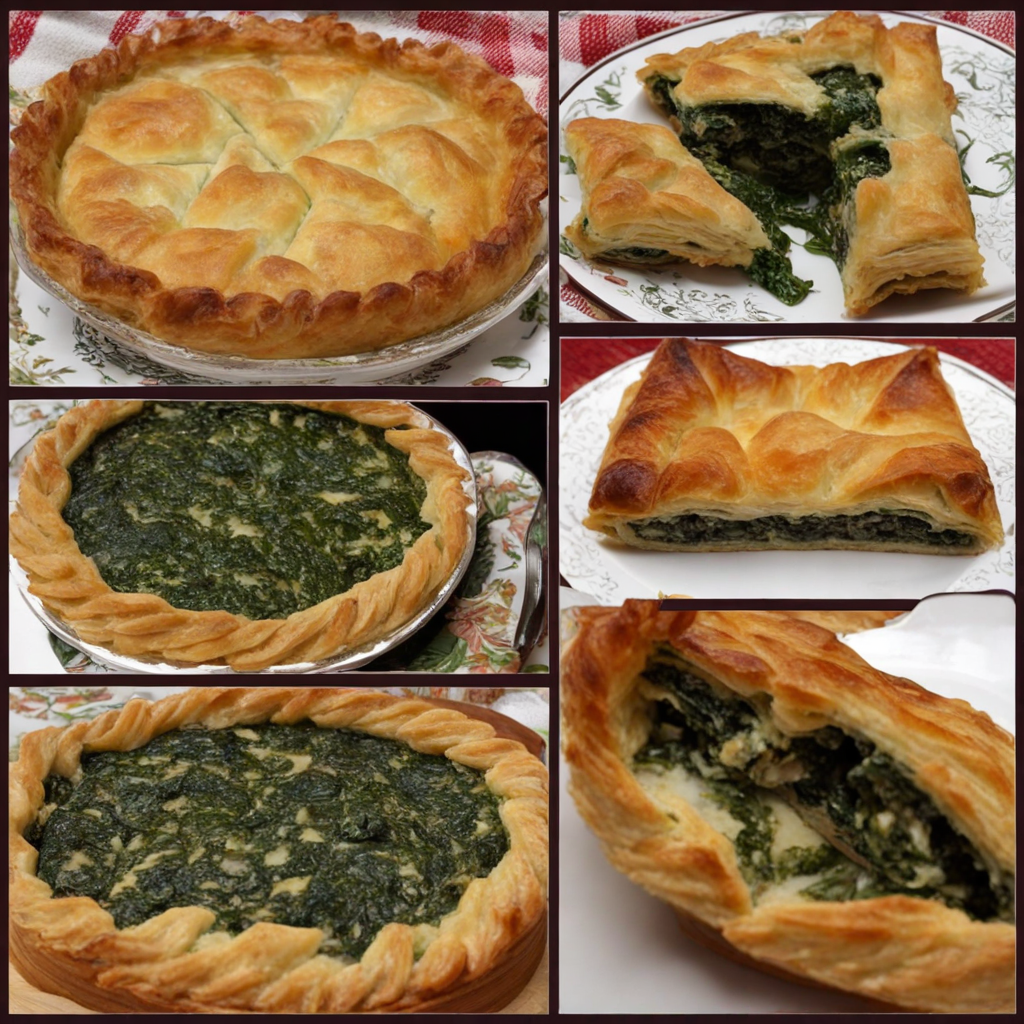Zeljanica
Zeljanica is a traditional Serbian dish that embodies the rich culinary heritage of the Balkans. This savory pie is primarily made with layers of thin, flaky dough, known as phyllo, which is filled with a delightful mixture of fresh greens, typically including spinach, chard, and sometimes wild herbs. The greens are often combined with creamy feta cheese or other local cheeses, and sometimes enriched with eggs, creating a harmonious blend of flavors. The contrast between the crispy, golden-brown crust and the tender, flavorful filling makes each bite a delicious experience. The preparation of Zeljanica showcases the skill and care that goes into Serbian cooking. The phyllo dough is stretched and layered meticulously, allowing for an airy texture that complements the moist filling. Once assembled, the pie is baked until it's perfectly golden, with the aroma of baked greens and melted cheese wafting through the kitchen. It’s often served hot out of the oven, making it a comforting and satisfying dish that can be enjoyed at any meal, from breakfast to dinner. Zeljanica can be enjoyed on its own or paired with a dollop of yogurt or sour cream on the side, which adds a refreshing tang that balances the richness of the pie. This dish not only represents the flavors of Serbia but also reflects the country's agricultural bounty, utilizing seasonal greens and regional ingredients. Whether enjoyed at a family gathering or as part of a festive celebration, Zeljanica is a true testament to the warmth and hospitality found in Serbian cuisine.
How It Became This Dish
The Culinary Journey of Зељаница: A Serbian Delicacy #### Origins and Ingredients Зељаница, often referred to as "zeljanica" in English, is a traditional Serbian dish that embodies the rich culinary heritage of the Balkans. It is a savory pastry filled primarily with greens, particularly a mix of spinach and other leafy vegetables, and is encased in layers of dough. The origins of зељаница can be traced back to the agricultural practices of the region, where the abundance of fresh greens in spring and early summer inspired the creation of this wholesome dish. The name "зељаница" derives from the Serbian word "зелје," which means "greens" or "vegetables." Historically, this dish was born out of necessity, as rural households sought to make the most of seasonal produce. The basic ingredients of зељаница include flour, water, salt, and oil for the dough, while the filling can vary widely, incorporating not just spinach but also chard, wild greens, or even herbs like dill and parsley. In many recipes, the filling is often enriched with cheese, such as feta or cottage cheese, providing a creamy contrast to the earthy flavors of the greens. #### Cultural Significance In Serbian culture, food is deeply intertwined with identity, family, and tradition. Зељаница is not merely a meal; it is a symbol of communal gatherings and celebrations. It often graces tables during significant occasions, including Orthodox Christian holidays and family gatherings, showcasing the importance of sharing food as a means of bonding and connection. The preparation of зељаница can also be seen as a communal activity. Families often come together to prepare the dish, each member contributing to the rolling of dough and the mixing of filling. This tradition reinforces familial ties and offers an opportunity to pass down culinary skills from one generation to the next. In this way, зељаница is not only a delicious dish but also a vessel for cultural preservation and storytelling. In a broader context, зељаница reflects the agricultural calendar of Serbia, where the arrival of spring heralds the harvest of various greens. This seasonal aspect is significant in Serbian culture, as it highlights the connection between the land, the food it produces, and the people who cultivate it. Eating зељаница in spring symbolizes a celebration of nature’s bounty and the cyclical nature of life. #### Development Over Time The evolution of зељаница can be seen through the lens of changing culinary practices and societal influences. While its basic form has remained relatively unchanged, the dish has undergone variations that reflect the integration of new ingredients and techniques over time. In the early 20th century, with urbanization and industrialization, many rural families migrated to cities, leading to a fusion of culinary traditions. In urban centers, зељаница began to incorporate more diverse ingredients, and the methods of preparation evolved. Modern conveniences, such as store-bought dough, made the dish more accessible, allowing families to enjoy зељаница without the labor-intensive process of making dough from scratch. This shift did not diminish the dish’s cultural significance; instead, it adapted to the changing lifestyles of Serbian people. Additionally, the globalization of food culture in the late 20th and early 21st centuries introduced zeljanița to new audiences. Serbian diaspora communities began to recreate the dish in their new homes, leading to variations influenced by local ingredients and culinary practices. In countries like the United States, Canada, and Australia, zeljanița has found its way onto restaurant menus, often accompanied by stories of its significance to Serbian heritage. As health consciousness has increased in recent years, zeljanița has also adapted to reflect modern dietary preferences. Today, variations can be found that cater to vegetarian, vegan, and gluten-free diets, showcasing the dish's versatility. Chefs have experimented with different types of greens, including kale and arugula, and alternative dough recipes, thus keeping the essence of зељаница alive while making it relevant to contemporary palates. #### Contemporary Zељаница: A Symbol of Resilience In contemporary Serbia, зељаница continues to hold a special place in the culinary landscape. It is often featured in restaurants specializing in traditional Serbian cuisine, where chefs pay homage to their roots by preparing the dish with locally sourced ingredients. Moreover, food festivals and cultural events frequently highlight зељаница, celebrating its role in Serbian heritage and fostering a sense of community among participants. In rural areas, the traditional preparation of зељаница persists, with many families maintaining their unique recipes that have been passed down through generations. Local fairs often showcase homemade зељаница, where visitors can taste authentic versions of the dish while experiencing the warmth of Serbian hospitality. The dish has also garnered attention for its nutritional benefits. Rich in vitamins, minerals, and fiber, зељаница is celebrated not only for its delightful flavors but also for its contribution to a balanced diet. This emphasis on health has led to renewed interest in traditional Serbian dishes, as they align with modern dietary trends prioritizing wholesome, natural ingredients. #### Conclusion The journey of зељаница from a humble rural dish to a beloved staple of Serbian cuisine is a testament to the resilience and adaptability of culinary traditions. Rooted in the agricultural practices of the region, it reflects the deep connection between people, land, and food. As it continues to evolve, зељаница remains a symbol of cultural identity, communal bonds, and the enduring legacy of Serbian food heritage. From family gatherings to restaurant menus, зељаница is more than just a dish; it is a celebration of life, nature, and the traditions that bind generations together. Whether enjoyed in its traditional form or adapted for modern tastes, зељаница will undoubtedly continue to delight and nourish those who partake in its rich flavors and history for years to come.
You may like
Discover local flavors from Serbia







